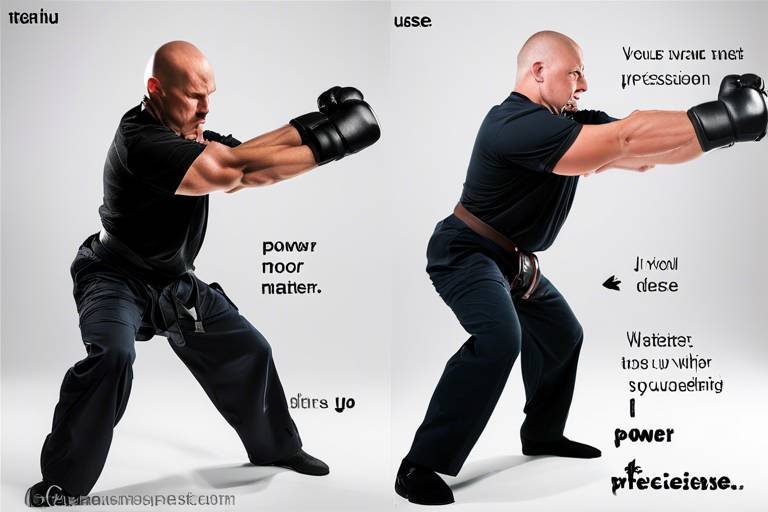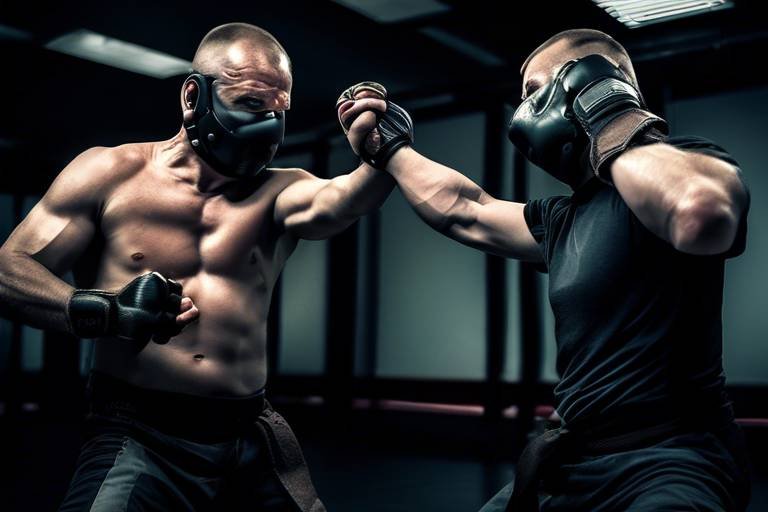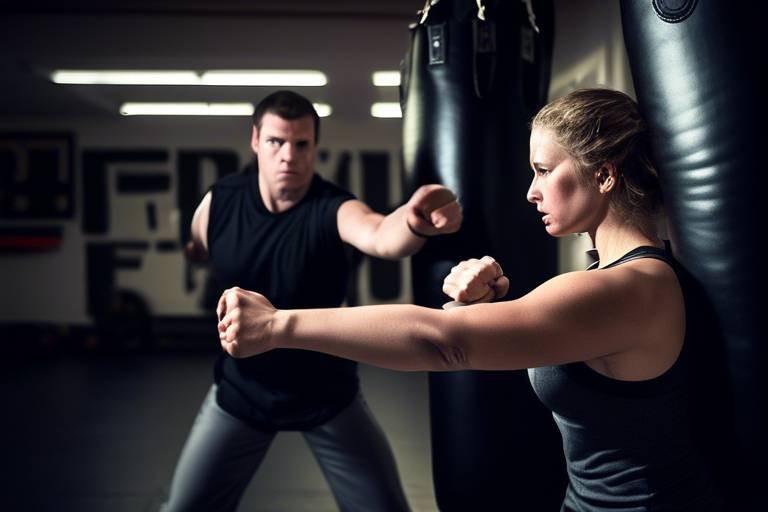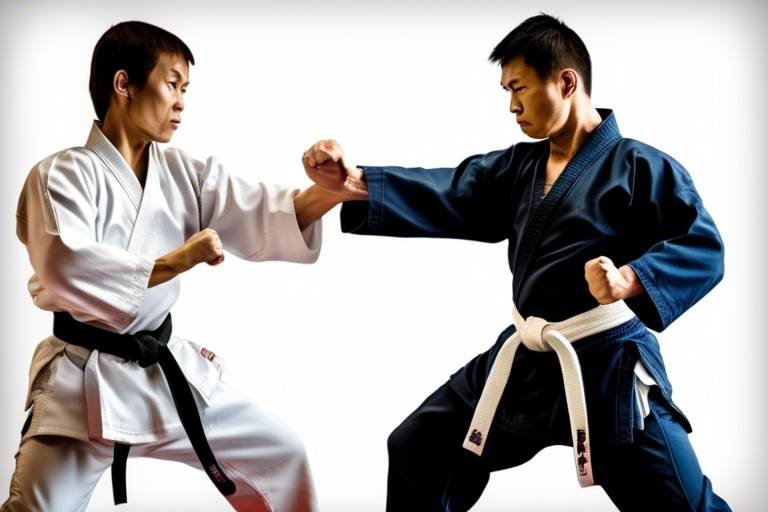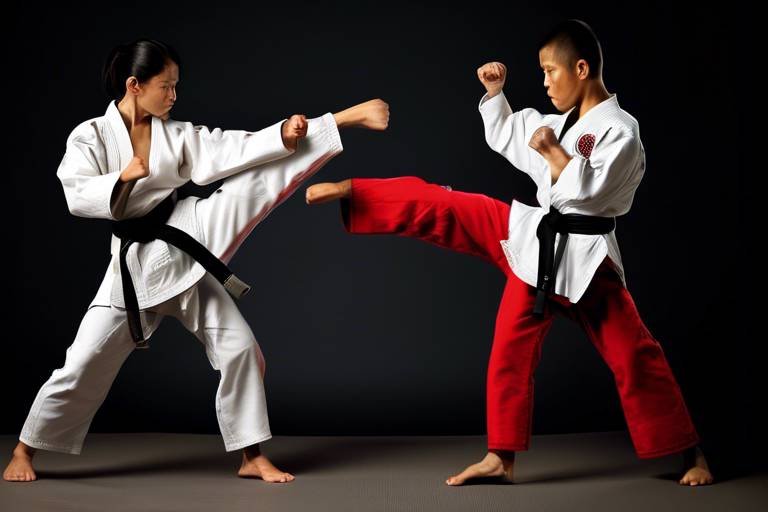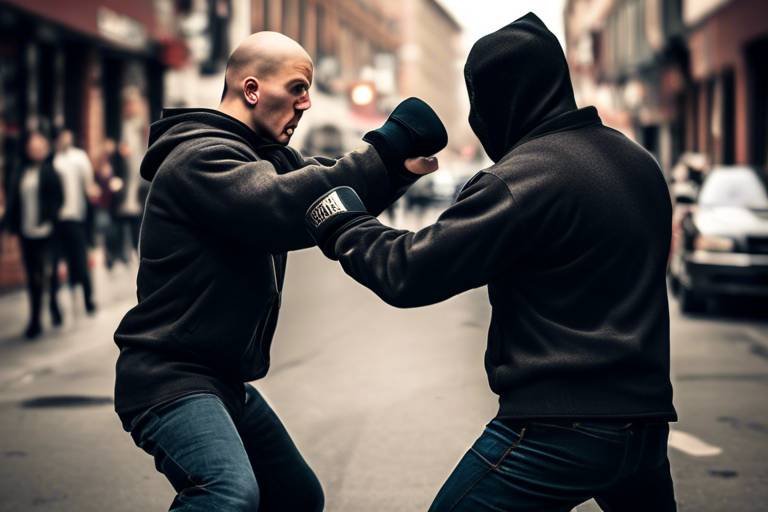Power versus Precision - Which Matters More in Self-Defense Techniques?
When it comes to self-defense, the age-old debate of power versus precision often arises. Imagine standing face to face with an attacker; would you prefer a strong punch that could knock them out or a precise strike that targets their most vulnerable spots? The truth is, both elements are crucial in self-defense, and understanding their significance can make all the difference in a life-threatening situation. In this article, we will explore the delicate balance between power and precision, examining how each contributes to effective self-defense techniques and how they can be integrated for optimal personal safety.
Power is undeniably a vital component of self-defense. When you deliver a strong strike, it can not only deter an attacker but also provide you with a sense of security. Think of power as the thunder in a storm—while it may not always be necessary, when it strikes, it commands attention. Understanding the dynamics of power allows individuals to defend themselves more effectively in dangerous situations. For instance, if you can generate enough force behind a punch or kick, you might just be able to incapacitate your attacker long enough to escape. However, relying solely on brute strength can be a mistake; that’s where precision comes into play.
Precision is equally important in self-defense techniques. It’s not just about how hard you hit, but where you hit. A well-placed strike can maximize the effectiveness of your defensive moves, even if your power is somewhat limited. Imagine trying to knock down a brick wall with a gentle tap versus hitting a weak point in the wall with a targeted blow. This is the essence of precision in self-defense. By honing your accuracy, you can effectively target vulnerable areas of an attacker’s body, ensuring that your strikes have the greatest impact possible.
Identifying and striking vulnerable areas can significantly enhance the effectiveness of your self-defense techniques. These areas are often less protected and can lead to immediate incapacitation of an attacker. Common targets include:
- Eyes: Aiming for the eyes can temporarily blind or disorient an attacker.
- Throat: A strike to the throat can disrupt breathing and create an opportunity to escape.
- Groin: A well-placed kick to the groin can incapacitate even the most determined assailant.
Knowing how to aim for these critical areas during a confrontation is essential. It’s not just about the strength of your attack, but the accuracy that allows you to maximize your defensive capabilities.
Here’s a quick rundown of the most effective vulnerable targets on an assailant's body:
| Target Area | Effect |
|---|---|
| Eyes | Disorientation |
| Throat | Breathing disruption |
| Groin | Incapacitation |
Understanding why these areas are critical can empower you to act quickly and effectively when faced with danger.
To enhance your accuracy, specific techniques can be employed. It’s all about mastering your body mechanics and maintaining mental focus. Practicing the following can help:
- Shadow boxing to simulate real-life scenarios.
- Target practice with pads or bags to improve your aim.
- Visualization techniques to mentally prepare for strikes.
By integrating these techniques into your training regimen, you can execute precise strikes even in high-pressure situations.
Ultimately, integrating power and precision is essential for effective self-defense. It’s like a dance—one without the other can lead to missteps. Training methods that enhance both attributes will create a well-rounded self-defense skill set. Consider incorporating strength training alongside accuracy drills to ensure you’re not just hitting hard, but also hitting smart.
Achieving a balance between power and precision requires targeted training. This means focusing on drills that develop both aspects, ensuring that you’re prepared for any situation. Whether you’re working on striking power or honing your accuracy, it’s crucial to maintain a holistic approach to your training.
Specific drills designed to increase striking power can be incorporated into your self-defense routine. These may include:
- Heavy bag workouts to build strength.
- Plyometric exercises to enhance explosive power.
- Resistance training to improve overall muscle strength.
On the other hand, drills that focus on accuracy are equally important. Incorporate activities such as:
- Shadow boxing to practice form and technique.
- Target practice with focus mitts to refine your aim.
- Reaction drills to simulate real-life scenarios.
By dedicating time to both power and precision training, you’ll create a formidable self-defense skill set that prepares you for any encounter.
Q: Is it better to focus on power or precision in self-defense?
A: Both are important. Power can deter an attacker, while precision ensures effective strikes. A balance of both is ideal.
Q: How can I improve my precision in self-defense?
A: Practice drills like shadow boxing and target hitting to enhance your accuracy and aim.
Q: What are the most vulnerable areas to target in a self-defense situation?
A: Common targets include the eyes, throat, and groin, which can incapacitate an attacker effectively.

The Importance of Power in Self-Defense
When it comes to self-defense, power is often viewed as a key component that can make or break a defensive strategy. Imagine being in a situation where your safety is at stake. The sheer force behind your strike can be the difference between escaping danger and becoming a victim. Strong strikes not only have the potential to incapacitate an attacker but also serve as a deterrent. An assailant is less likely to engage if they know their target can deliver a powerful counterattack.
Understanding the dynamics of power in self-defense is crucial. It’s not just about swinging wildly; it’s about harnessing your body’s strength effectively. Think of it like a well-coiled spring: the tighter you can wind it, the further it can launch when released. This analogy highlights the importance of both strength and technique. Without the right technique, all the power in the world won’t help you land a successful strike.
Moreover, the psychological aspect of power cannot be overlooked. When you train to develop your striking power, you build confidence. This newfound confidence can change your mindset, making you feel more secure in your ability to handle threatening situations. It’s like carrying a shield; while you may not always need it, just having it gives you peace of mind.
Power in self-defense can be broken down into several key elements:
- Physical Strength: This includes muscle mass and conditioning, which are crucial for delivering effective strikes.
- Technique: Proper form and execution can amplify your natural strength, making your strikes more effective.
- Speed: The quicker you can deliver a strike, the more powerful it can be, as speed adds momentum.
Incorporating strength training into your self-defense routine can significantly enhance your overall power. Exercises like squats, deadlifts, and push-ups can build the muscle groups that contribute to effective striking. Additionally, plyometric exercises can improve your explosive strength, enabling you to deliver faster and more powerful strikes.
In conclusion, while precision is undeniably important, the foundation of effective self-defense often lies in the power behind your techniques. By focusing on building your physical strength and mastering your technique, you can create a robust self-defense strategy that not only protects you but also empowers you in the face of adversity.
Q: How can I improve my striking power?
A: To improve your striking power, focus on strength training exercises, practice proper technique, and incorporate speed drills into your routine.
Q: Is power more important than precision?
A: Both power and precision are crucial in self-defense. However, the effectiveness of your techniques often hinges on how well you can deliver powerful strikes accurately.
Q: What types of exercises help build power for self-defense?
A: Exercises such as squats, deadlifts, and plyometric drills are excellent for building the strength and explosiveness needed for powerful strikes.

The Role of Precision in Self-Defense
When it comes to self-defense, precision is often the unsung hero. Sure, you might think that delivering a powerful punch is all that matters, but let’s face it: if you can’t hit your target, all that strength is pretty much useless. Precision allows you to strike effectively and efficiently, making it a crucial component of any self-defense strategy. Imagine trying to hit a bullseye with a bow and arrow; if your aim is off, you might as well be shooting into the sky. In self-defense, your aim is everything.
But what does precision really mean in the context of self-defense? It’s about knowing where to hit and how to hit. The human body has several vulnerable areas that, when targeted correctly, can incapacitate an attacker. Think of it as a game of chess: knowing the right moves can be the difference between winning and losing. In a self-defense scenario, striking a vulnerable target can make your escape much easier, even if your strength isn't on par with your attacker’s.
Identifying and striking vulnerable areas can significantly enhance the effectiveness of self-defense techniques. These areas include:
- Eyes: A quick jab or poke can temporarily blind an attacker, giving you a chance to escape.
- Throat: A swift strike here can disrupt breathing and cause immediate incapacitation.
- Groin: A well-placed kick can cause intense pain and immobilize an assailant.
By honing in on these targets, you can maximize your chances of defending yourself successfully, even if your strikes aren't the most powerful. This is where the beauty of precision shines through.
To achieve that level of precision, you need to focus on specific techniques that enhance your accuracy. It’s not just about throwing punches; it’s about understanding your body mechanics and maintaining mental focus. For instance, practicing shadow boxing allows you to visualize your movements and refine your technique without the pressure of a real-life confrontation. You can also incorporate drills that involve hitting targets, which can sharpen your aim significantly. Think of it as training your brain and body to work together seamlessly—like a well-oiled machine.
Moreover, staying calm under pressure is essential. When faced with an attacker, your heart may race, and your mind may cloud with fear. However, if you can channel that adrenaline into focused energy, you’ll find that your precision improves. It’s akin to a sniper taking a deep breath before pulling the trigger; that moment of calm can make all the difference.
While precision is vital, it doesn’t stand alone. The best self-defense techniques marry both power and precision. Think of a skilled archer who not only knows how to aim but also has the strength to shoot the arrow with enough force to penetrate the target. In self-defense, it’s about training to develop both attributes, ensuring that when the moment arises, you’re ready to strike effectively and powerfully.
In conclusion, precision in self-defense is not just a nice-to-have; it’s a must-have. By targeting the right areas and mastering the techniques that enhance your accuracy, you can significantly improve your chances of successfully defending yourself. Remember, it’s not about being the strongest person in the room; it’s about being the smartest and most precise. So, gear up, practice, and make precision your ally in the art of self-defense!
Q: How can I improve my precision in self-defense?
A: Practicing techniques like shadow boxing, target drills, and focusing on body mechanics can greatly enhance your accuracy.
Q: Is power more important than precision?
A: Both are important, but precision can often turn a weaker strike into a more effective one by targeting vulnerable areas.
Q: How do I stay calm in a self-defense situation?
A: Practice mindfulness techniques and breathing exercises to help keep your mind clear and focused when under pressure.

Targeting Vulnerable Areas
When it comes to self-defense, understanding the anatomy of an attacker can be the difference between escaping a dangerous situation and becoming a victim. of the body is not just a smart strategy; it's a critical component of effective self-defense. The human body has specific spots that, when struck, can incapacitate an aggressor quickly, allowing you to escape and seek safety. By focusing on these areas, even someone with limited strength can leverage their ability to defend themselves effectively.
Imagine yourself in a confrontation. Your heart races, your palms sweat, and your instincts kick in. In such moments, knowing where to aim can turn the tide. Vulnerable areas include the eyes, throat, and groin, among others. Each of these targets holds the potential to cause significant disruption to an attacker's ability to continue their assault. For instance, a quick jab to the eyes can momentarily blind an assailant, giving you precious seconds to escape. Similarly, a strike to the throat can disrupt breathing, while a well-placed kick to the groin can incapacitate an attacker long enough for you to get away.
Here’s a breakdown of some common vulnerable targets and why they matter:
| Vulnerable Area | Effect of Strike |
|---|---|
| Eyes | Temporary blindness, distraction |
| Throat | Disruption of breathing, shock |
| Groin | Severe pain, incapacitation |
| Solar Plexus | Knocks wind out, disorientation |
| Knees | Instability, loss of balance |
Understanding how to accurately strike these areas is equally important. In high-pressure situations, your body might instinctively react, but having a plan can help you stay focused. Practicing these strikes in a controlled environment, such as during self-defense classes, can enhance your muscle memory and improve your chances of hitting these targets effectively when it counts.
Moreover, it's not just about brute force; it’s about strategic thinking. Each situation is different, and you may need to adapt your approach based on the circumstances. For example, if you find yourself in a close encounter, aiming for the throat or eyes might be more feasible than a kick to the groin. The key is to remain calm and make quick decisions based on what you’ve practiced.
Ultimately, targeting vulnerable areas is a skill that can significantly improve your self-defense capabilities. By honing your ability to identify and strike these critical spots, you’re not just reacting to an attack; you’re taking control of the situation. Remember, the goal of self-defense is not to engage in a fight but to escape safely.

Common Vulnerable Targets
When it comes to self-defense, knowing where to strike can make all the difference in a high-stress situation. In the heat of a confrontation, your ability to identify and target vulnerable areas on an assailant's body can significantly enhance your chances of defending yourself effectively. These vulnerable targets are typically sensitive areas that, when struck, can incapacitate or deter an attacker, giving you the precious moments needed to escape.
Some of the most effective vulnerable targets include:
- Eyes: Striking the eyes can cause temporary blindness and disorientation, providing an opportunity to flee.
- Throat: A well-placed strike to the throat can disrupt breathing and incapacitate an attacker.
- Groin: Aiming for the groin is often effective due to the intense pain it can cause, which can incapacitate an assailant momentarily.
- Solar Plexus: A strike to this area can knock the wind out of someone, making it difficult for them to continue the attack.
- Knees: Targeting the knees can destabilize an attacker, making it hard for them to pursue you.
Understanding these targets is crucial, but it's equally important to practice your aim. In a self-defense scenario, you may only have a split second to react, so honing your ability to strike these areas accurately can be a game-changer. Remember, a powerful strike is only effective if it lands where it counts. Thus, training to improve your precision is just as vital as building your power.
Incorporating drills that focus on these vulnerable areas can help you become more adept at targeting them during a confrontation. For example, practicing with a partner using pads or bags can simulate real-life scenarios where you need to hit these critical points quickly and accurately. The more familiar you become with these targets, the more instinctive your responses will be during an actual encounter.

Techniques for Accurate Strikes
When it comes to self-defense, the ability to deliver accurate strikes can be the difference between escaping a dangerous situation and becoming a victim. Precision is not just about hitting the target; it's about hitting the right target at the right moment. To enhance your accuracy in self-defense scenarios, you need to focus on a few key techniques and principles that can dramatically improve your striking ability.
First and foremost, understanding body mechanics is crucial. This involves knowing how to align your body to generate maximum force while maintaining control. For instance, when delivering a punch, your feet, hips, and shoulders should work in unison. A common mistake is to rely solely on arm strength, which often leads to inaccurate strikes. Instead, practice generating power from your legs and core, transferring that energy through your arms to your target.
Mental focus also plays a significant role in accuracy. In high-pressure situations, it’s easy to become overwhelmed and lose sight of your target. To combat this, practice visualization techniques. Imagine your target clearly in your mind before executing your strike. This mental preparation can help you remain calm and composed, allowing for a more precise execution of your technique.
Another effective method to improve your accuracy is through target practice. This can be done using a variety of tools, such as focus mitts, heavy bags, or even training with a partner. Here are some techniques to consider:
- Shadow Boxing: This technique allows you to practice your strikes without the pressure of an opponent. Focus on form and precision as you visualize an opponent in front of you.
- Pad Work: Working with a partner who holds pads can help you identify your striking zones and improve your accuracy. Aim for specific spots on the pads to develop precision.
- Drills: Incorporate drills that require you to strike specific targets in rapid succession. This not only improves accuracy but also conditions you to respond quickly in real-life situations.
Finally, consider the importance of breathing techniques. Proper breathing can enhance your focus and help you maintain control over your body during a confrontation. Practice exhaling sharply as you strike; this not only helps with power but also keeps your mind clear and focused on your target.
By integrating these techniques into your training routine, you can significantly enhance your accuracy in self-defense situations. Remember, it's not just about how hard you hit; it's about how effectively you can hit where it counts.

Combining Power and Precision
When it comes to self-defense, the age-old debate of power versus precision often arises. While both elements are crucial, the real magic happens when you learn to combine them effectively. Think of it like a well-orchestrated dance; each movement must be executed with grace and strength to create a stunning performance. In the context of self-defense, this means that a powerful strike can be rendered ineffective if it misses its target. Conversely, a precise strike that lacks power may not deter an attacker. Therefore, mastering the art of combining power and precision is essential for anyone looking to enhance their self-defense skills.
To achieve this balance, practitioners should focus on integrated training methods that emphasize both attributes. For instance, consider incorporating drills that not only build strength but also improve accuracy. One effective way to do this is by using a combination of heavy bags for power training and focus mitts for precision practice. By alternating between these training methods, you can develop a well-rounded skill set that prepares you for real-world encounters.
Moreover, mental focus plays a significant role in this combination. Imagine you’re in a high-pressure situation; your heart is racing, and adrenaline is pumping. It’s easy to lose sight of your target, but maintaining mental clarity can help you execute precise strikes with power. Visualization techniques, where you mentally rehearse your moves, can be incredibly beneficial. Picture yourself delivering a powerful punch to an opponent’s vulnerable area—this mental exercise not only boosts your confidence but also enhances your physical performance.
In addition, the importance of proper body mechanics cannot be overstated. When you strike, your body should work as a cohesive unit. For example, when throwing a punch, it's not just your arm that does the work; your legs, hips, and core must all engage to generate maximum force. Training drills that focus on body alignment and movement can significantly improve your ability to strike hard and accurately. A well-executed strike uses the entire body, making it not only more powerful but also more precise.
Lastly, remember that practice makes perfect. Regularly scheduled training sessions that focus on both power and precision will lead to gradual improvement. Whether you’re practicing in a dojo or at home, set aside time to hone both skills. You might find it helpful to keep a training journal, tracking your progress and identifying areas for improvement. This way, you can ensure that both power and precision are part of your self-defense repertoire.

Training for Balance
Achieving a balance between power and precision in self-defense is not just a matter of luck; it requires dedicated training and a clear understanding of both elements. Think of it as a dance where every step must be synchronized for the performance to be captivating. In self-defense, this means that every strike should not only be powerful but also accurate. The goal is to create a seamless blend of these two attributes, ensuring that you can defend yourself effectively in any situation. Training should focus on developing strength while also honing the skills necessary to strike with precision.
One effective way to train for this balance is through a combination of strength training and technique drills. For instance, lifting weights can enhance your overall power, making your strikes more impactful. However, without the ability to aim those strikes accurately, the power becomes less effective. Therefore, integrating specific drills that focus on both power and precision is essential. Below are some training methods that can help you develop this balance:
- Shadow Boxing: This exercise allows you to practice your strikes without a partner. Focus on your form and aim for imaginary targets, enhancing both your speed and accuracy.
- Heavy Bag Training: Hitting a heavy bag can build strength and power in your strikes. Aim for specific areas of the bag to simulate targeting vulnerable spots on an assailant.
- Focus Mitts: Working with a partner using focus mitts can help you improve your accuracy while also allowing you to practice powerful strikes.
In addition to these drills, it’s crucial to incorporate mental training into your routine. Visualization techniques can be incredibly beneficial. Picture yourself in a real-life scenario, successfully executing a powerful and precise strike. This mental rehearsal can enhance your confidence and improve your reaction time in stressful situations.
Lastly, consider the importance of feedback in your training. Whether through video analysis or having a coach observe your technique, understanding how you can improve will help you refine your skills. Remember, training for balance is an ongoing process, and continuously challenging yourself will lead to better outcomes in self-defense situations.
| Question | Answer |
|---|---|
| What is more important in self-defense, power or precision? | Both power and precision are crucial; however, precision can often make a powerful strike more effective by targeting vulnerable areas. |
| How can I improve my striking power? | Incorporate strength training exercises, such as weightlifting and resistance training, into your routine. |
| What drills can help improve my accuracy in self-defense? | Practicing shadow boxing, using focus mitts, and targeting specific areas on a heavy bag can enhance your accuracy. |
| Is mental training important for self-defense? | Absolutely! Visualization and mental rehearsal can improve your confidence and reaction times during real-life confrontations. |

Drills to Enhance Power
When it comes to self-defense, having powerful strikes is not just about brute strength; it's about how effectively you can deliver that strength in a high-pressure situation. The right drills can help you build and enhance your striking power, making you a formidable opponent should the need arise. One of the most effective ways to develop power is through strength training and specific conditioning exercises that focus on explosive movements.
A great starting point is incorporating plyometric exercises into your routine. These exercises, which include movements like jump squats and box jumps, are designed to improve your explosive strength. For instance, performing jump squats not only targets your legs but also engages your core, providing a solid foundation for powerful strikes. When you jump and then land back into a squat, you’re training your muscles to exert force rapidly, which translates directly into your self-defense techniques.
In addition to plyometrics, consider integrating weighted strikes into your training. This can be done using resistance bands or light weights while practicing your punches and kicks. For example, you might perform a series of punches with a resistance band around your wrists or use light dumbbells to simulate the weight of a strike. This method not only builds muscle but also improves your neuromuscular coordination, making your strikes more effective when you need them most.
Another excellent drill for enhancing power is the heavy bag workout. Hitting a heavy bag allows you to practice your strikes with full force, simulating a real-life scenario. Here’s a simple routine to follow:
| Round | Duration | Focus |
|---|---|---|
| 1 | 3 minutes | Jabs and crosses |
| 2 | 3 minutes | Hooks and uppercuts |
| 3 | 3 minutes | Kicks and knees |
| 4 | 3 minutes | Combination strikes |
During each round, focus on maximizing your power with every strike. It’s not just about speed; it’s about ensuring that your technique is sound so that the power translates effectively. Remember to breathe properly and engage your core during strikes to maximize force.
Lastly, don’t underestimate the importance of mental conditioning. Visualization techniques can significantly enhance your striking power. Spend a few minutes each day visualizing yourself executing powerful strikes in a self-defense scenario. Imagine the impact and the force behind each move. This mental rehearsal can boost your confidence and help your body respond more effectively when it matters.
In conclusion, enhancing your striking power in self-defense involves a combination of physical training, technique practice, and mental conditioning. By incorporating these drills into your routine, you can develop the strength and explosiveness necessary to defend yourself effectively.
- What are the best exercises for increasing striking power? Plyometrics, weighted strikes, and heavy bag workouts are excellent choices.
- How often should I train for power? Aim for at least 2-3 times a week, integrating power drills into your regular workout routine.
- Can I enhance power without weights? Yes! Bodyweight exercises and plyometrics can significantly improve your power.
- Is mental conditioning really effective? Absolutely! Visualization can enhance your confidence and performance in high-pressure situations.

Drills to Improve Precision
When it comes to self-defense, precision can often be the deciding factor between success and failure. Imagine finding yourself in a high-pressure situation where every second counts. You need to strike effectively, but how do you ensure that your hits land where they matter most? This is where specific drills designed to enhance your precision come into play. By incorporating these drills into your training routine, you can develop the necessary skills to execute accurate strikes even when adrenaline is pumping through your veins.
One of the most effective drills for improving precision is shadow boxing. This technique allows you to practice your movements without the pressure of an opponent. By visualizing an attacker, you can focus on your footwork, angles, and, most importantly, the accuracy of your strikes. Shadow boxing not only helps you to refine your technique but also builds muscle memory, making it easier to execute precise movements in real-life situations. Aim to spend at least 10-15 minutes each training session on shadow boxing, concentrating on your form and the targets you would aim for in a confrontation.
Another excellent drill is target practice. This can be done using a punching bag or a specially designed target pad. Set up targets at varying heights and distances, and practice striking them with precision. You can even use items like tennis balls attached to a string to simulate a moving target. This adds an element of unpredictability to your training, forcing you to focus on your accuracy as you strike. To make this drill more effective, consider tracking your progress over time. For instance, keep a record of how many precise strikes you can land in a minute, and aim to improve that number with each session.
In addition to these drills, incorporating partner drills can also enhance your precision. Working with a partner allows you to practice striking at a moving target, which is crucial for developing your timing and accuracy. Start slow, allowing your partner to move around while you focus on landing strikes with precision. As you become more comfortable, gradually increase the speed and unpredictability of your partner's movements. This will simulate a more realistic self-defense scenario, pushing you to hone your skills under pressure.
Remember, the key to improving precision is consistent practice. Make it a point to integrate these drills into your regular training routine. Set specific goals for each session, whether it’s improving your accuracy on a target or increasing the speed at which you can land a precise strike. The more you practice, the more confident you will become in your ability to defend yourself effectively. With dedication and a focus on precision, you’ll be well on your way to mastering the art of self-defense.
- What is the most important aspect of self-defense, power or precision? Both power and precision are crucial; however, precision often plays a more vital role in successfully defending oneself.
- How often should I practice precision drills? Aim to practice precision drills at least 2-3 times a week to see significant improvement.
- Can I practice precision drills alone? Yes, many precision drills like shadow boxing and target practice can be done solo, although partnering up can enhance your training.
- What are some common mistakes to avoid when practicing precision? Common mistakes include rushing through drills, neglecting form, and failing to focus on targeting vulnerable areas.
Frequently Asked Questions
- What is more important in self-defense: power or precision?
Both power and precision are crucial in self-defense. Power can deliver strong strikes that deter an attacker, while precision allows you to target vulnerable areas effectively. The best approach is to integrate both elements for maximum effectiveness.
- How can I improve my striking power?
Improving your striking power involves specific training drills such as strength training, conditioning exercises, and practicing your techniques with focus on generating force. Incorporating weights and resistance training can also enhance your overall strength, contributing to more powerful strikes.
- What are some common vulnerable targets to aim for in a confrontation?
Common vulnerable targets include the eyes, throat, groin, and solar plexus. Striking these areas can incapacitate an attacker quickly, giving you a chance to escape. Understanding where to aim is essential for effective self-defense.
- Can I train for both power and precision at the same time?
Absolutely! Many training drills can enhance both power and precision simultaneously. For instance, shadow boxing can help with accuracy while also building strength if you focus on explosive movements. The key is to balance your training regimen to include exercises that target both attributes.
- What drills can help improve my precision in self-defense?
Drills like target practice, shadow boxing, and using focus mitts can significantly improve your precision. These exercises help you develop accuracy in your strikes and better aim at vulnerable areas, which is crucial in a self-defense situation.
- Is it possible to learn self-defense techniques online?
Yes, many online resources, including video tutorials and virtual classes, can teach you self-defense techniques. However, it's beneficial to practice in person with a qualified instructor to ensure proper technique and feedback.
- How often should I train to maintain my self-defense skills?
Consistency is key! Training a few times a week is ideal to maintain and improve your self-defense skills. Regular practice helps reinforce techniques and builds muscle memory, which is essential in high-pressure situations.

